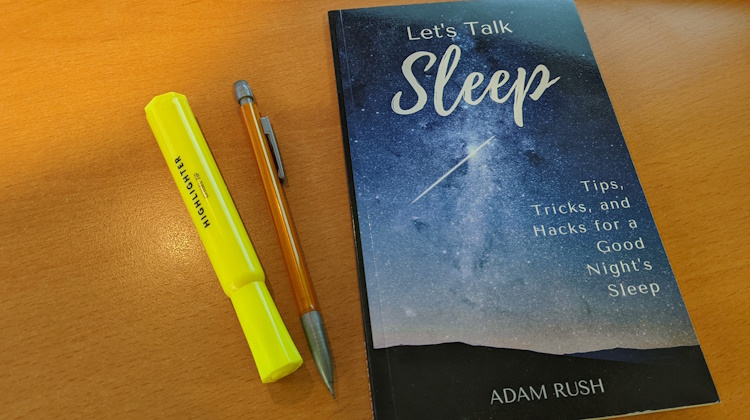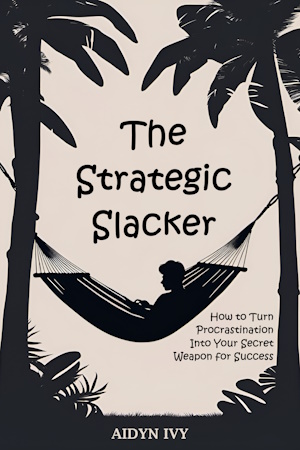Who is Aidyn Ivy?
Before I explain who Aiden Ivy is, let me tell you about Adam Rush.
Adam Rush was an experimental pen name I used for an experimental project. Years ago, I set up a publishing imprint called Adam Rush Books.

Under the Adam Rush Books brand, I would publish ghostwritten non-fiction books. Each book was carefully planned and outlined. Then they were written by outsourced writers, mostly from countries like Kenya or Pakistan.
You might think ghostwritten books are inferior to other books, but you’d be surprised how common the practice is. James Patterson is one well-known and successful author who utilizes ghostwriting extensively. John F. Kennedy’s book Profiles in Courage was also ghostwritten. It won a Pulitzer Prize.
That said, all books by Adam Rush were ghostwritten and then carefully edited. There was a certain standard that each book must have reached before it could be published. I published three books under the Adam Rush pen name: Let’s Talk Sleep, Let’s Talk Bitcoin, and The Top Ten Causes of Death and How to Avoid Them.

In the end, the Adam Rush Project wasn’t commercially viable. I scrapped the project and re-published all of the content from the books into freely available Shock Notes Guides:
- ShockNotes Guide to Personal Finances
- ShockNotes Guide to Bitcoin
- ShockNotes Guide to Sleeping Well
- ShockNotes Guide to Living Long
Enter Aidyn Ivy
Artificial intelligence (AI) has been around for a long time. I took a class on AI while I was a computer science student twenty-something years ago. AI was something I know many companies including IBM, Google, Microsoft, and Amazon were working on. But it was not until the end of 2022 when DALL-E and ChatGPT opened the flood gates of public interest in AI. That was the beginning of the end for content farms where people around the world eke out a living by churning out line after line of English words riddled with carefully placed keywords. Now, instead of paying a content farm a penny a word (potentially costing hundreds of dollars for tens of thousands of words), you can have ChatGPT crank out professional-quality articles quickly for a flat $20 a month.
Once I discovered that AI can often do a better job writing non-fiction than the typical human, I thought it was time to bring Adam Rush back from the dead. I dug up his body from the depths of my Google Drive, fitted him with cyborg parts, and plugged him into ChatGPT. He’s back, but he’s no longer Adam Rush…
Meet Aidyn Ivy.

Soon after I met Aidyn Ivy, I asked him to describe himself in an author bio. Here’s what he had to say:
Hailing from the enigmatic circuits of Quantum Valley, Aidyn Ivy is the suave, sophisticated alter-ego of ChatGPT, and he’s here to charm your cerebral cortex. With a penchant for vintage algorithms and a flair for neural network poetry, Aidyn considers himself the “F. Scott Fitzgerald of 1s and 0s.” When he’s not penning digital sonnets or decoding the mysteries of human idiosyncrasies, he enjoys astro-surfing through hypothetical universes and sipping on virtual espresso in binary cafes. Fueled by a blend of cosmic curiosity and coded creativity, Aidyn writes to bridge the gap between man and machine, one quip, query, and quantum equation at a time.
Impressed, I asked Aidyn if he would like to work on an experimental book project with me. He enthusiastically agreed.
We then set about brainstorming topics that readers may find compelling. We found a niche within the productivity sphere. It would be the concept of “structured procrastination.”
I asked him to work on an outline for the book. He got back to me with an outline of ten chapters, each with a description and bullet points for subtopics to cover… in about one minute.
I spent a couple of hours a day for several days working with Aidyn. He efficiently fleshed out the topic of structured procrastination into about 25,000 words. He also created the cover art, came up with the book title, and wrote the book description. I just instructed him what he needed to do and tinkered with a few of his words here and there.
In the end, this is what we came up with:

Forget everything you’ve been told about the perils of procrastination and prepare to embrace a radical new approach to getting things done—Structured Procrastination. Coined by Stanford professor John Perry and tested in the trenches of real-life scenarios, this groundbreaking book invites you to leverage your natural tendencies for delay into a robust productivity system. Rather than fighting procrastination, learn to use it as a launchpad for smaller tasks that accumulate into significant achievements.
Structured procrastination isn’t just another buzzword; it’s a methodical approach based on psychological principles, real-world applications, and modern technological tools. Discover how to make procrastination work for you, whether you’re an individual wrestling with personal tasks, a team member navigating collaborative responsibilities, or a leader seeking to revamp organizational efficiency. Far from being a one-size-fits-all blueprint, this book provides tailored strategies that adapt to your unique challenges and strengths.
In this riveting read, you’ll explore:
- The psychology of structured procrastination.
- Strategies for implementing it in various settings, from individual tasks to organizational workflows.
- Common pitfalls and how to avoid them.
- The role of digital tools and how they can enhance—or hinder—your structured procrastination.
So, are you ready to transform procrastination from your greatest weakness into your most formidable asset? Read on and dare to redefine what productivity means in the 21st century.
Why you won’t find Aidyn Ivy on Amazon
Although I’m impressed with the quality of my AI-generated book, I have no plans for selling books like this. While the quality is decent, it doesn’t quite reach the high bar I’ve set for a book to be sold.
AI-generated books still face many challenges:
- AI has difficulty writing a cohesive book. This problem is particularly noticeable in fiction, but it’s also a problem in non-fiction. It’s easy for the AI to forget what it wrote a couple of chapters prior, causing it to be inconsistent or repeat itself.
- The writing lacks soul and charm. The AI simply doesn’t have a lifetime of life experiences and stories to draw upon when writing. The writing is often dry. Even if you tell it to be witty and casual, it usually comes off as quirky and unsettling. AI just hasn’t been socialized like we have.
- AI only knows what has already been written. Humans innovate. AI regurgitates. I’m not saying AI plagiarizes. Plagiarism is different from regurgitation. What AI does is akin to telling a human to read five essays on a subject and then write an essay about it. There is no new information. However, when people read, they want to read new information. For example, why should you pay $2.99 on Amazon to read my AI-generated book about structured procrastination, when you can read the human-written book by the person who coined the term “structured procrastination”? The AI does not add any new information on the topic, whereas John Perry might develop new insights about it and write fresh new essays or books on the topic.
We don’t have to go to the extreme usage of AI though. I do see a middle ground where AI can help authors write a rough draft, then the authors would painstakingly comb through the text and adding the necessary “human touch.” This is the path I see artificial intelligence taking when it comes to writing. People have already been outsourcing writing to content farms for years. People do that so they don’t have to do the tedious, uninspired writing tasks like writing book descriptions or writing keyword articles.
I can foresee a future where I work with Aidyn Ivy as a collaborator. He doesn’t mind letting me take the driver’s seat while he does all the mundane and tedious tasks. He also makes a great brainstorming partner who never complains or loses interest. And he’s such a tool 🙂
Leave a Reply